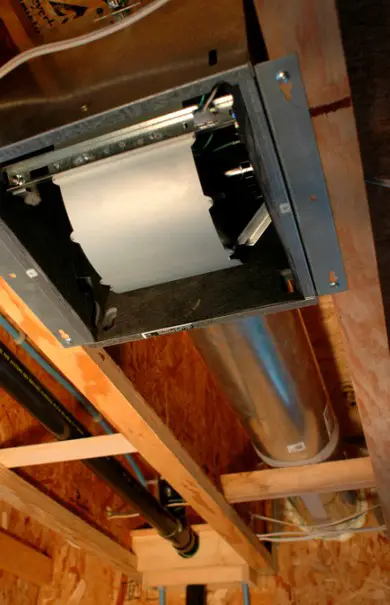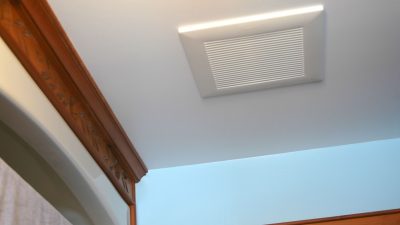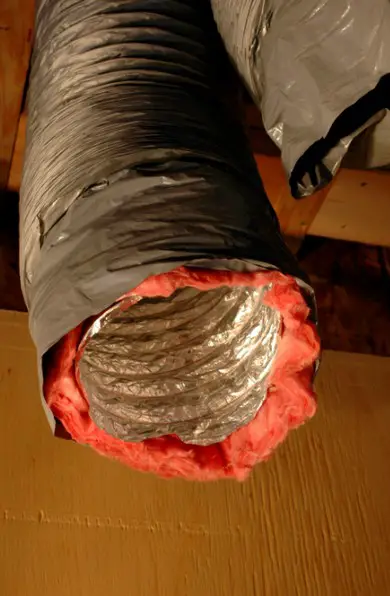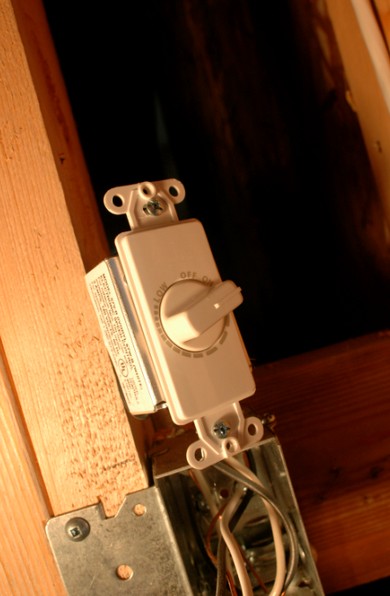 Colder weather brings special household challenges, and one of them is the need for effective bathroom ventilation. If a long, hot shower steams up your bathroom during warm weather, no problem. Just open a window and let the breeze take care of the mist. But now, as outdoor temperatures begin to drop, a good exhaust fan really proves its worth. Today’s best models move an amazing amount of air with surprisingly little noise. That’s a high performance model to the right that I put into one of my projects a while back. The key to success is understanding what to look for in new-generation exhaust fans and the details behind a first-class exhaust fan installation. Some builders and most homeowners get this all wrong.
Colder weather brings special household challenges, and one of them is the need for effective bathroom ventilation. If a long, hot shower steams up your bathroom during warm weather, no problem. Just open a window and let the breeze take care of the mist. But now, as outdoor temperatures begin to drop, a good exhaust fan really proves its worth. Today’s best models move an amazing amount of air with surprisingly little noise. That’s a high performance model to the right that I put into one of my projects a while back. The key to success is understanding what to look for in new-generation exhaust fans and the details behind a first-class exhaust fan installation. Some builders and most homeowners get this all wrong.
The most important job of any bathroom exhaust fan is to clear damaging levels of moisture out of your house fast, before it can ruin wall surfaces and window frames with mold and rot. That’s obvious. But this isn’t going to happen if the fan drives you insane with the kind of gravelly rattling racket that’s so common with standard-issue exhaust fans. People will simply opt not to switch the infuriating thing on.
I’ve been monitoring exhaust fan design for more than twenty years, and I’m glad to report that the noise of leading fans has been reduced to the point where it’s not an issue at all. In fact, we’re in greater danger of accidentally forgetting to switch these fans OFF rather than not running them often enough.Engineers use a unit of measurement called the “sone” to assess exhaust fan noise.
 One sone is roughly equivalent to 40 decibels. A quiet whisper is 15 to 25 decibels, and the background noise in a typical home or office measures 40 to 60 decibels. Today’s best bathroom exhaust fans come in at less than one sone, and they accomplish this thanks to the design of the fan cage itself, plus built-in acoustic insulation around the entire unit. Panasonic makes some exceptional exhaust fans – some of the very best I’ve ever seen and installed. They are my favourite. Broan Nu-Tone makes some great units, too. Expect to pay more than $200 for a good exhaust fan. Choose a model that can clear all the air in your bathroom at least 10 times each hour.
One sone is roughly equivalent to 40 decibels. A quiet whisper is 15 to 25 decibels, and the background noise in a typical home or office measures 40 to 60 decibels. Today’s best bathroom exhaust fans come in at less than one sone, and they accomplish this thanks to the design of the fan cage itself, plus built-in acoustic insulation around the entire unit. Panasonic makes some exceptional exhaust fans – some of the very best I’ve ever seen and installed. They are my favourite. Broan Nu-Tone makes some great units, too. Expect to pay more than $200 for a good exhaust fan. Choose a model that can clear all the air in your bathroom at least 10 times each hour.
But a good exhaust fan is only part of the recipe for success. The other part is ducting. If an exhaust duct travels through a heated space (like the floor joists between two fully-heated levels as shown above), then ordinary sheet metal ducting works fine. Just be sure to secure all joints with screws then apply aluminum tape to ensure no damp air escapes into  framing cavities.
framing cavities.
But if your exhaust duct runs through a cold area, such as an unheated attic, then you’ll need to use flexible, insulated duct material. That’s what you see to the right. This comes pre insulated, with vapour barrier plastic on the outside so the exhaust air stays warm on its route outdoors. Lots of installers ignore this crucial detail, and it inevitably leads to condensation and ice build up inside sheet metal exhaust ducting. This water could dribble back into your exhaust fan and out of the louvre. It could also seep out through a seam in the pipe, wetting your attic insulation in the process. Both conditions are bad news, and both are easily avoided. Just use insulated duct, and be sure to seal the duct and insulation where it joins to the fan and the outdoor wall or roof louvre.
As I mentioned before, the only problem with quiet exhaust fans is that they’re so very quiet. You can leave them on accidentally and this translates into excess home energy use.  Besides the electricity wasted on operating the fan itself, a much larger waste is the energy required to heat the cold, outdoor air that moves into your house to replace the warm air expelled by the fan.
Besides the electricity wasted on operating the fan itself, a much larger waste is the energy required to heat the cold, outdoor air that moves into your house to replace the warm air expelled by the fan.
This is why any new exhaust fan installation should include a timer, or better yet, an automatic humidistat control. This turns the fan on when humidity levels rise to a preset level, and off again when they drop. Get all these exhaust fan details correct, and you’ll enjoy the kind of quiet, aggravation-free ventilation that all homes need.